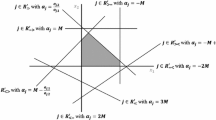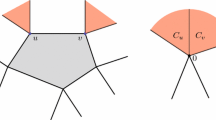Abstract
We present a new network simplex pivot selection rule, which we call theminimum ratio pivot rule, and analyze the worst-case complexity of the resulting network simplex algorithm. We consider networks withn nodes,m arcs, integral arc capacities and integral supplies/demands of nodes. We define a {0, 1}-valued penalty for each arc of the network. The minimum ratio pivot rule is to select that eligible arc as the entering arc whose addition to the basis creates a cycle with the minimum cost-to-penalty ratio. We show that the so-defined primal network simplex algorithm solves minimum cost flow problem within O(nΔ) pivots and in O(Δ(m + n logn)) time, whereΔ is any upper bound on the sum of all arc flows in every feasible flow. For assignment and shortest path problems, our algorithm runs in O(n 2) pivots and O(nm +n 2 logn) time.
Similar content being viewed by others
References
R.K. Ahuja, T.L. Magnanti and J.B. Orlin,Network Flows: Theory, Algorithms, and Applications (Prentice Hall, Englewood Cliffs, NJ, 1993).
R.K. Ahuja and J.B. Orlin, The scaling network simplex algorithm,Operations Research 40 (1992) Supplement 1, S5-S13.
M. Akgul, Shortest path and simplex method, Research Report, Department of Computer Science and Operations Research, North Carolina State University, Raleigh, NC, 1985.
M. Akgul, A genuinely polynomial primal simplex algorithm for the assignment problem,Discrete Applied Mathematics 45 (1993) 93–115.
W.H. Cunningham, A network simplex method,Mathematical Programming 11 (1976) 105–116.
W.H. Cunningham, Theoretical properties of the network simplex method,Mathematics of Operations Research 4 (1979) 196–208.
M.L. Fredman and R.E. Tarjan, Fibonacci heaps and their uses in improved network optimization algorithms, in:Proceedings of the 25th Annual IEEE Symposium on Foundations of Computer Science (1984) 338–346; also:Journal of ACM 34 (1987) 596–615.
D. Goldfarb and J. Hao, Polynomial-time primal simplex algorithms for the minimum cost network flow problem, Technical Report, Department of Industrial Engineering and Operations Research, Columbia University, New York, 1988.
D. Goldfarb, J. Hao and S. Kai, Efficient shortest path simplex algorithms,Operations Research 38 (1990) 624–628.
R.M. Karp and J.B. Orlin, Parametric shortest path algorithms with an application to cyclic staffing,Discrete Applied Mathematics 3 (1981) 37–45.
J.B. Orlin, On the simplex algorithm for networks and generalized networks,Mathematical Programming Study 24 (1985) 166–178.
J.B. Orlin, A polynomial time primal network simplex algorithm for minimum cost flows (1997).
R.E. Tarjan, Efficiency of the primal network simplex algorithm for the minimum-cost circulation problem,Mathematics of Operations Research 16 (1991) 272–291.
Author information
Authors and Affiliations
Corresponding author
Rights and permissions
About this article
Cite this article
Sokkalingam, P.T., Sharma, P. & Ahuja, R.K. A new pivot selection rule for the network simplex algorithm. Mathematical Programming 78, 149–158 (1997). https://doi.org/10.1007/BF02614367
Received:
Revised:
Issue Date:
DOI: https://doi.org/10.1007/BF02614367




